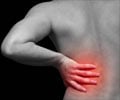Acupuncture can help people with chronic low back pain feel less bothered by their symptoms and function better in their daily activities.
Acupuncture can help people with chronic low back pain feel less bothered by their symptoms and function better in their daily activities, according to the largest randomized trial of its kind, published in the May 11, 2009 Archives of Internal Medicine. But the SPINE (Stimulating Points to Investigate Needling Efficacy) trial raises questions about how the ancient practice actually works.
Compared to the group that got usual care, results were similar for all three of the SPINE trial's acupuncture groups: individualized, standardized, and simulated (without going through skin). Of the people who got any kind of acupuncture, an extra one in five were functioning significantly better at the end of the seven-week treatment—and an extra one in eight were still functioning better at one year."This study suggests that acupuncture is about as effective as other treatments for chronic back pain that have been found helpful," said SPINE trial leader Daniel C. Cherkin, PhD, a senior investigator at Group Health Center for Health Studies in Seattle. "But we found that simulated acupuncture, without penetrating the skin, produced as much benefit as needle acupuncture—and that raises questions about how acupuncture works."
The SPINE trial included 638 adult patients at two nonprofit health plans: Group Health Cooperative in Seattle and Northern California Kaiser Permanente in Oakland. They all rated the "bothersomeness" of their chronic low back pain as at least a 3 on a 0-to-10 scale. None of them had received acupuncture before. They were randomly assigned to one of four groups:
- Individualized needle acupuncture, involving a customized prescription for acupuncture points from a diagnostician
- Standardized needle acupuncture, using a single prescription for acupuncture points on the back and backs of the legs, which experts consider generally effective for chronic low back pain
- Simulated acupuncture on those same standardized points, mimicking needle acupuncture but instead of a needle using a toothpick in a needle guide tube without penetrating the skin
- Usual care, which is the standard medical care they would have gotten anyway—and that all patients in all groups received
The SPINE team found that at eight weeks all three acupuncture groups were functioning substantially better, while the group getting only usual care was functioning only slightly better. Dysfunction scores improved significantly more for all three acupuncture groups than for the usual care group. These benefits lasted for a year, although they waned over time.
Notably, the outcomes for groups that received the needle and simulated forms of acupuncture did not differ significantly. So, although acupuncture effectively treated low back pain, that therapeutic benefit seemed to require neither tailoring acupuncture needle sites to an individual patient nor inserting needles into the skin.
Advertisement
Western medicine does not have highly effective medical treatments for chronic back pain, Cherkin said. Back pain is the number-one reason that Americans use complementary and alternative medicine (CAM), including acupuncture.
Advertisement
"The findings of this research show that acupuncture-like treatments, including simulated acupuncture, can elicit positive responses," said Josephine P. Briggs, MD, director of NCCAM. "This adds to the growing body of evidence that something meaningful is taking place during acupuncture treatments outside of actual needling. Future research is needed to delve deeper into what is evoking these responses."
Source-Eurekalert
SRM








